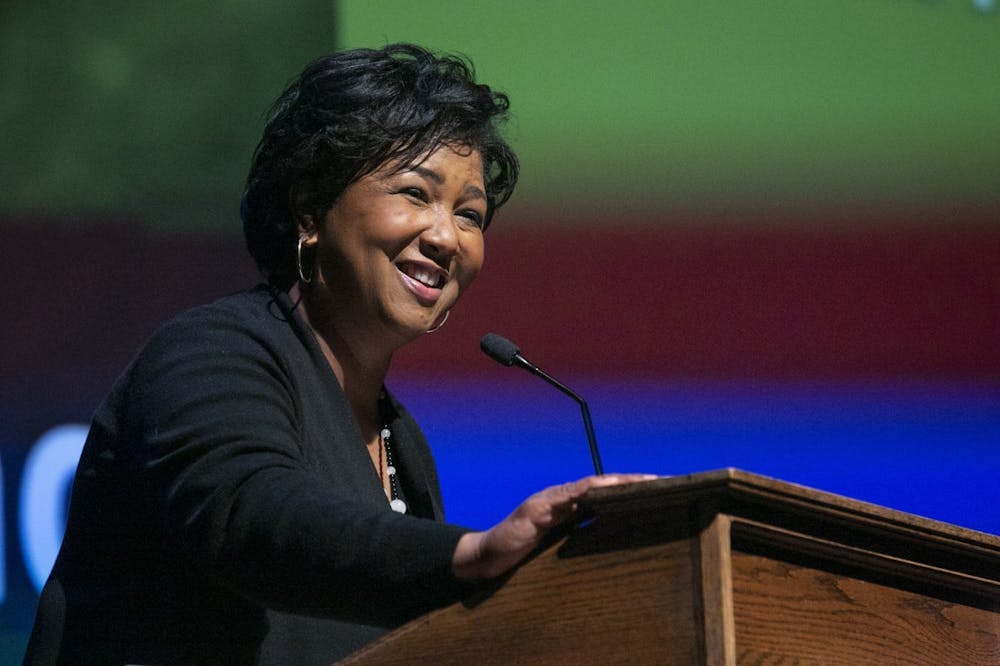Mae Jemison shot for the moon, and she very nearly got there.
Jemison, former NASA astronaut and the first woman of color in the world to go into space, shared how her personal experiences of finding confidence and a place at the table shaped the work she does today—as well as her visions for human interstellar space travel.
Invited through the Baldwin Scholars' Jean Fox O’Barr distinguished speaker series, Jemison described growing up in the 1960s as living in a period of change where people stood up and asserted their right to participate.
“And that’s the person I grew up to be,” she said. “That’s how I thought of the world—that I would be able to participate.”
Participating, however, wasn’t all smooth sailing. Jemison told the audience that in order to use her skills, experiences and authority to “make things happen,” she had to be confident and empowered.
She shared a story of when, at age 26, she went to Sierra Leone with the Peace Corps after pausing her studies at Weill Cornell Medicine to pursue medicine in developing countries. As a volunteer and the youngest person on staff, she was responsible for the healthcare for all the volunteers in the U.S. Department of State personnel.
Two weeks in, she dealt with a volunteer who had what he thought to be malaria but which she diagnosed as meningitis. Using and trusting her background in medicine and diseases, Jemison took the authority to call a military authority evacuation. The volunteer survived.
“This whole time when we look at the issue of confidence, we look at the issue of ‘how do you dare to do something that other people don’t?’” Jemison said. “I think it’s by thinking through what it is you want to do. You have to value, corral and protect your energy as well.”
The challenge once people have a place at the table, she said, is having the confidence to maintain that spot and using experiences to shape our work rather than trying to submerge them.
Jemison felt this confidence also transferred into her work with NASA. Space, she said, is ubiquitous and commonplace; it’s everywhere. Weather systems, GPS satellites and medical devices are all connected to space and through space.
Jameson argued that space exploration is part of our entire world and society—“it’s just whether or not we have more people included in it,” she said.
“Once I was selected for the astronaut program, what difference would it have made if I were there and I acted just like everyone else and I minded my table manners?” she asked. “What difference would it have made if I didn’t use the experience and the knowledge I had from being a Peace Corps medical officer and working in developing countries? Of having grown up on the South Side of Chicago, of having danced?”
Jemison said that this and the thought of endless possibilities inspired her to take her next step in space exploration—forming her global initiative, 100 Year Starship, which seeks to guarantee capabilities for human travel to another star within the next 100 years while simultaneously transforming life on Earth.
She is committed to interstellar space exploration because she doesn’t think “Mars pushes us hard enough.” Although it’s still an engineering challenge, Jemison said that it’s already known where Mars is and how to get to it.
Interstellar, however, is different.
“The extreme nature of interstellar hurdles actually make us re-evaluate what we think we know, and it demands a radical leaps in all of our disciplines and our knowledge and our technology, our systems, our capabilities. Every human discipline will be pushed,” she said.
Jemison said that the challenge of interstellar travel necessitates deeper inquiry into who is participating, who is at the table. Jemison led “An Inclusive Audacious Journey Transforms Life Here on Earth and Beyond,” a project which involves including different races, genders and disciplines. She hopes that she will be able to include more people from different fields and make them feel comfortable participating.
She added that the challenge of human interstellar travel mirrors the challenges that we face in the world today—challenges like world hunger, how to keep the integrity of biodiversity and maintain our energy requirements.
“We have an opportunity to think about how we might operate on a starship that contains 5,000 people, and how do we transfer that knowledge base to our starship that we’re on right now?” Jemison asked. “That’s the challenge, that’s the beauty of it.”
Many of our problems, she said, stem from our lack of appreciation for our connections across space and time. She said that it’s not for a complete lack of capacity of capability that we cannot solve global issues outlined in the United Nations’ Sustainable Development Goals—it’s for a lack of commitment and connection.
Get The Chronicle straight to your inbox
Sign up for our weekly newsletter. Cancel at any time.
Reminding herself of the connections that we do share, Jameson remembered the simple act of looking up at the sky as a little girl in Chicago.
“What’s above us unites us,” she said. “Because we really do share the same atmosphere that carries our weather around. We see some of the same stars, we see the same moon, we see the same sun.”

Mona Tong is a Trinity senior and director of diversity, equity and inclusion analytics for The Chronicle's 117th volume. She was previously news editor for Volume 116.

